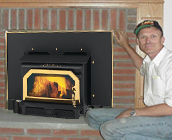Fireside
Formerly Wakefield Stove
JohnDebar@gmail.com
Fireside Online Located at  Phone: 401- 783-6054 Email: johndebar@gmail.com
Phone: 401- 783-6054 Email: johndebar@gmail.com 

52 Main St, Wakefield, RI.
 Phone: 401- 783-6054 Email: johndebar@gmail.com
Phone: 401- 783-6054 Email: johndebar@gmail.com 
-
Fireside Stove Shoppe
Amazing!
The flash combustion of smoke!
The flash combustion of smoke!
Wood Burning Draft Performance Tips to Stop Smoking Issues
Insuring draft performance requires discovering the drafting variables external to the chimney. This varies from home to home. It also varies as homes gradually get tighter, type fire starter used, wood moisture content, and any or all of the homes venting appliances/fans. These factors are listed below.
Trial and error trouble shooting is simple and fast. It is the job of the resident, both in learning, and in executing these procedures, each time as necessary.
- A. If smoking occurs when starting, then there are steps to take to cover all 3 possible causes.
Sometimes it is one, or a combination of the 3 below. - 1. Have the kindling and fire starter in place, but do not fire up until after step 2.
The dryer the kindling the better. The fire starter can't be tightly rolled/folded paper, or anything that smolders and smokes with relatively little flame heat. Try 'fatwood', fire starter, or a small chunk of wax 'Duraflame log. Get it match ready, but do not light yet. - 2. Initialize the draft by pre-warming the flue pathway.
Open the damper or loading door for an hour prior to use. If cold air is coming down, shut off all drafting appliances, that are drawing in this cold air, such as the furnace, dryer, vent fans, etc.
Cold air present in the chimney resists rising or 'drafting'. Get the drafting started by igniting a single sheet of newspaper without folding it tight, after placing it up into the damper area or stove. Unfolded, it will flare up quickly and go out in seconds. This produces a burst of high heat, with the least smoke. Loose and virtually unfolded, it will go out in seconds. Repeat a few times if necessary. This will quickly lessen the cold heavy air in chimney, and get the smoke moving up and out faster. When pre-warmed, light the fire starter. - 3. if smoking persists after steps 1 and 2, try again with a window open a few inches.
When the fire has been going hot for 10 minutes, you may be able to shut the window. Here is why you open a window: Home air leaving via the fireplace averages 60 cubic feet /minute, less with a wood stove. This air going up the chimney needs to be supplied back into the home. Overly air tight homes fail to provide enough volume of air back into the home. Drafty windows serve a purpose!
New homes are now required by code to have a small, permanently open 'window' in the basement, called a 'make up air device'. New homes may have outside air piped directly to the furnace air intake, but it is necessary for tight homes to have another air intake feeding the homes open space. You'll feel a bit of cold air blowing into your basement. Without this air intake, make up air for other venting appliances is pulled down through the wood burning chimney, pulling in the smoke with it. Smoking gets worse when all of the other appliances, listed below, are exhausting at the same time. (Anything exhausting is consuming home air, which must be replaced by outside air) Examples of other appliances are the furnace, dryer, kitchen and bath vents, and some roof/attic ridge vents. If smoking is lessened by supplying make-up air from a window you open as a test, then remember to crack a window slightly when burning, or perhaps just initially when the chimney draft is weak when cold starting - B. On days over 50 degrees, and when outside & inside temperatures are similar, chimneys perform worse than ever. When this temperature difference increases, so does the drafting. It is on these warmer days days that following the above tips is even more important.
C.
Optimize your fire wood!
Rarely is seasoned wood delivered fully seasoned. There is a world of difference in the two when it comes to drafting and smoke issues. Freshly cut 'green' wood must be dried for 1.5 years, over the course of two summers, split & covered. Commercially seasoned wood refers to green wood that has been seasoning for just a year. All seasoned wood delivered in the fall will need another 'spring to fall' period to get the last pound or two of water from every log. Just one pound of water is a pint. Loading eight logs adds a gallon of water to the fire. Wet wood weakens drafting, and dirties the chimney.
Here's the problem wood dealers often face. Wood dealers cut and split in the spring, sits there over the summer, and then loaded and delivered to you; their job is done. If instead they had to deliver it to their own property to fully season an added summer, it would require storage handling and space, and more travel and labor to again load and deliver. Doubling work would be prohibitive for the wood dealer to be cost competitive, so don't expect to ever receive a cord of fully seasoned wood, just buy 'seasoned' in the spring.D.
Problem chimneys are those that are short, and/or shorter than roof height, and/or have a large fireplace opening, and/or have a small diameter smoke pathway. However, rarely are these construction weaknesses the sole determining cause of smoke back puffing.